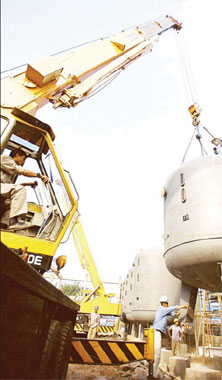Seawater toilets help flush away water shortages
By Chen Xiaorong ( China Daily )
Updated: 2009-09-10
|
|||||||||
|
Workers install seawater desalination facilities. The present daily output of China's desalinated water accounts for 0.3 percent of the world's total output. Ma Yidong |
Residents of Qingdao's Haizhiyun neighborhood were the first on the Chinese mainland to have their homes fitted with a system that uses seawater to flush toilets.
The pilot project, which started two years ago in the coastal brewery city, received official approval this June and is part of the country's efforts to solve its growing water shortage problem.
One resident, Li Tong, 62, said he was delighted with the result, which he found more hygienic and economical.
"The saltwater is so good," he said.
"More importantly, our monthly expenditure for water usage has been cut by a quarter," he said.
Qingdao is just one of 400 Chinese cities which suffer from acute shortages of water. One-third of household water consumption in China is used to flush toilets.
The 800 residents in the pilot project pay 0.7 yuan per ton for processed seawater, which is about one-third of the average price of tap water in the city.
If 50 percent of Haizhiyun residents (about 1,000 households) use seawater to flush their toilets, they will collectively save 378 tons of fresh water and save $110 in water charges every day.
"We are so proud to introduce this eco-friendly project into our community," said Xiao Shengyan, deputy general manager of Qingdao Longhai Group Co Ltd, the developer of Haizhiyun.
The seawater must be purified, disinfected and biochemically treated at a plant that cost $878,000 to build. The government paid five-sixths of the price, and Quingdao Longhai Group paid the remainder.
"Although it cost us an extra $140 per household to build dual flushing facilities in each home, we will see a profit in 10 years, when freshwater will cost a lot more," Xiao said.
Treated seawater is also used in the community swimming pool and can be used in domestic aquariums.
Some environmentalists are calling for an increase in the number and size of desalination plants that treat seawater, saying they can meet much more of the country's freshwater needs.
Already 80 percent of Hong Kong's population uses seawater for flushing toilets.
"We are facing a shortage of water resources around the world," said Ho Pui-yin, director of the Hong Kong History Resource Center at the city's Chinese University.
Water from Dongjiang, in Guangdong province, accounts for 70 percent to 80 percent of Hong Kong's freshwater. Ho said Hong Kong should not remain dependent on that source alone.
Wang Duo, an associate professor in the College of Chemistry and Chemical Engineering at Qingdao's Ocean University of China, believes expanding the country's desalination infrastructure will greatly relieve strain on its freshwater supplies.
Desalination plants were introduced in China in 1958. Now there are more than 20 operations extracting salt from seawater and purifying the water.
These include the relatively large-scale Shandong Huangdao and Hebei Huanghua power plants, the No 7 Petroleum Factory of China Petroleum Dalian Petrochemical Corp, the Tianjin Economic and Technological Development Area, Shandong Yantai City and Hebei Wangtan Power Plant. They produce about 30,000 tons of clean water a day.
Most desalination businesses with an annual production capacity of more than 100,000 tons cooperate with foreign companies such as General Electric and Befesa.
The ambitious Spanish developer Befesa made inroads into Qingdao's market by constructing a seawater reverse osmosis plant in 2007.
At present, the daily output of China's desalinated water accounts for 0.3 percent of the world's total output. Authorities say the target for 2010 is to produce up to 1 million tons per day.
China is regarded by the United Nations as one of the 13 most water-deficient countries in the world. As supplies dry up, the cost of water will rise.
The advancement of seawater desalination technology has brought down its high cost. China, however, relies largely on foreign equipment and expertise.
Some industry insiders believe that overseas investors should be encouraged to undertake desalination projects in China.
According to the China Seawater Desalination Annual Report (2007), foreign desalination equipment providers will control 50 percent of China's market within the next three to five years.
"The government should have a policy to subsidize and offer tax incentives to domestic and overseas operators to encourage them to undertake the risk in this high-cost industry," said Kang Jian, an official from the State Oceanic Administration.
In Hong Kong, some environmentalists suggest the government set up a medium-sized desalination demonstration plant to supply salt-free water to a small community as a foundation for further studies.
But the seawater desalination in the city is still expensive, despite lowering costs over recent years.
(China Daily 09/10/2009 page39)




